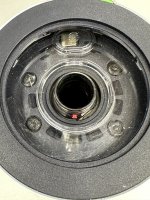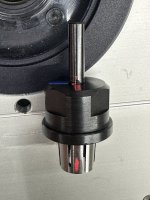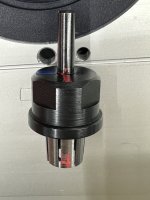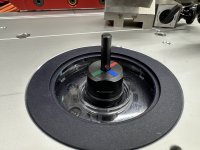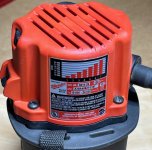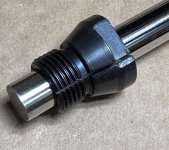Michael Kellough said:
[member=44099]Cheese[/member] being educated as an artist I often get engineering terms wrong.
1. I’m not sure what you mean by “address” but it seems the most important element in getting a shaft to spin true is the one we can’t do anything about. The spindle taper (“collet bore”?).
My OF 2200 spindle taper seems to spec out pretty well, .00025 at bottom, .0002 middle, .0002 top, but apparently it is bored with yaw relative to the spindle axis.
You said, “Once these positions are marked…”
2. I couldn’t see a way to mark positions without the collet removed from the spindle. Then only by marking the collet and the nut in places that can’t be seen from outside. Then I found that the collet would change position relative to the nut as it was tightened. Since the collet can’t be reliably adjusted to try and get an imperfection in the collet to compensate for the condition of the bore the I can’t think of any way to “address” my OF 2200 except with expletives.
1. You're correct, the dimensional accuracy of the collet bore along with its concentricity (to the router shaft) and perpendicularity (yaw) of it all determine router bit positional accuracy.
The dimensional accuracy is probably the least to worry about because it's a ground feature and the likely hood that it is egg-shaped is probably quite minimal. It could be a little too large or a little too small but the taper of the collet would compensate if those are minor variations.
The concentricity is an issue but it never changes, it's always the same so you can compensate for it by rotating the collet or just accept it as is and working with the offset in the finished product.
The perpendicularity issue (yaw) is my largest concern because it's not consistent. It's always producing different dimensional sizes depending upon how far the router bit protrudes from the collet nut.
2. You're correct again... [smile] Actually, the collet isn't changing position relative to the nut but rather, the nut changes position relative to the collet. So once the collet is inserted in the bore, it no longer moves, it's the nut that moves...that's a good thing because it becomes a repeatable datum.
This is how I'm going to go about it profiling the TIR for different combinations. I'll mark the router shaft in 4 positions with 4 different colored dots. Here's the first dot in red.
[attachimg=1]
I've already marked the 4 sections of the collet body 1-4.
[attachimg=2]
[attachimg=3]
I've already marked the dowel pin with a single alignment dot.
[attachimg=4]
What I controlled yesterday was the dot on the dowel pin relative to each collet body segment but I never controlled that combination to the collet bore in the router shaft. [doh]

